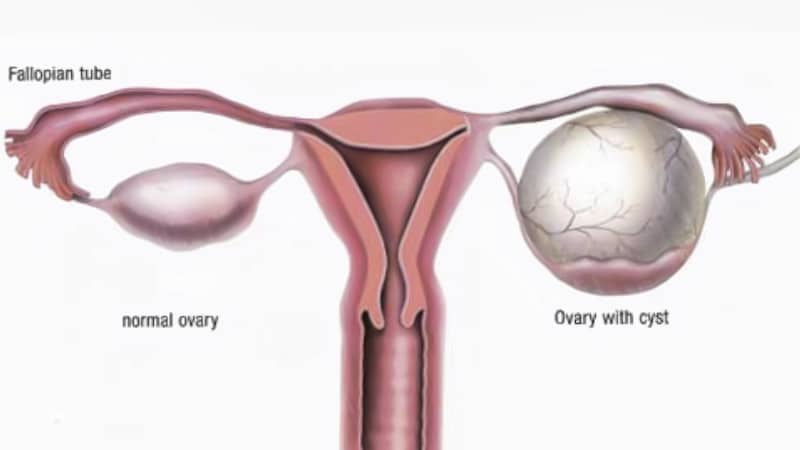The ovaries are two small reproductive organs in a woman’s body located on the left and the right of the uterus. The ovaries produce an ova or egg each month, release hormones like estrogen, and bring about menstruation.
Various kinds of cysts can form in or around the ovaries. Most ovarian cysts occur during the childbearing years. 75 – 85% of the ovarian cysts being benign, or non-cancerous, and would not require surgery.
Ovarian cysts cannot be prevented, but they mostly do not cause any symptoms, are not cancerous, and go away on their own.
Symptoms of Ovarian Cysts & Tumors
- Pain and/or bloating in the abdomen
- Fullness, pressure, swelling, heaviness, or pain in the abdomen
- Painful menstruation, abnormal bleeding, menstrual irregularities
- Frequent urination, difficulty emptying the bladder completely, pressure on the rectum or bladder
- Pelvic pain, a constant or irregular dull ache in the lower back and thighs
- Pelvic pain before menstruation and before it ends
- Pressure on the bowels, pain during bowel movements
- Painful intercourse
- Nausea, vomiting, weight gain, breast tenderness similar to pregnancy
- Losing appetite, feeling full quickly
What are Ovarian Cysts?
Ovarian cysts are fluid-filled sacs formed in or around the ovaries.
The most common type of ovarian cyst is the functional cyst. There are 2 types of functional cysts:
- Follicle cysts – A follicle or sac forms around the egg or the ovum and breaks open to release the egg during ovulation. A follicle cyst forms when the follicle does not break open to release the egg. Instead, the cyst keeps growing. Most follicle cysts go away within 1 – 3 months.
- Corpus luteum cysts occur when the sac seals over and continues to grow after the egg is released. These cysts can grow to almost 4 inches and may cause pain from bleeding or distorting the ovary. These cysts are usually benign, or non-cancerous, and usually, go away after a few weeks.
There are four other types of ovarian cysts:
3. Endometriomas occurs when cysts made up of uterine tissue attach to the ovary and form a growth. This type of cyst can be painful during sex and during menstruation.
4. Polycystic ovary syndrome (PCOS) occurs when mature eggs are not released from the sacs and grow. The cycle repeats itself, and many cysts form.
5. Cystadenomas are cysts that form on the outside of the ovaries and become filled with a watery fluid or a sticky gel. These cysts can grow large and cause pain.
6. Dermoid cysts contain many different cell types and may be filled with hair, teeth, and other tissues. These cysts can grow large and cause pain.
Causes of Ovarian Cysts
- History of ovarian cysts
- Irregular menstruation
- Increased upper body fat
- Early menstruation at age 11 or younger
- Infertility
- Used the drug Tamoxifen (Soltamox) for breast cancer
- Have hypothyroidism or hormonal imbalance
How Chiropractic Can Help Ovarian Cysts, Tumors
Chiropractic care can help ease pain and balance hormones when you have ovarian cysts. Lower back, pelvic, bowel movement, and menstrual pain and pressure may be relieved through chiropractic adjustments of the lower back. Nausea and vomiting may be relieved through chiropractic adjustments of the neck. Hormonal imbalances may be improved through adjustments of the spine and especially the thoracic spine and lower back. The chiropractic adjustments will improve nerve function and help to relieve pain and improve hormonal balance.
When to See a Doctor
Please seek immediate medical attention, if you have these symptoms:
- Pain, fever, vomiting
- Dizzy, Faint, weak
- Sudden severe abdominal pain
- Rapid breathing, cold or clammy skin
Treatment for Ovarian Cysts
When a doctor determines that you have a cyst, you will most likely be asked to wait and be examined again in 1 – 3 months to see if the cyst has changed in size.
When a cyst is found, a doctor may use an ultrasound to determine the cyst’s shape, size, location, and mass (determine what is inside the cyst). You may also be given a pregnancy test to rule out pregnancy, hormone level tests to determine any hormone-related issues, and a blood test to determine if the cyst is cancerous.
Surgery may be an option if you are postmenopausal or if it continues to grow, causes pain, and does not reduce or disappear after several menstrual cycles.
- Laparoscopy is done when the cyst is small and probably benign or non-cancerous. General anesthesia is given and a small cut is made above or below the navel. An instrument is inserted and the cyst removed.
- Laparotomy is done when the cyst is large and possibly cancerous. Under general anesthesia, a large incision is made in the abdomen and the cyst removed. The cyst is tested for cancer, and the doctor may need to remove the ovary and other tissues like the uterus.
Ovarian cysts cannot be prevented, but they mostly do not cause any symptoms, are not cancerous, and go away on their own.
For Chiropractors
Advising the patients on benefits of a mostly raw organic vegan diet and vegetable juicing may be helpful in naturally balancing a patients hormones.
I’m a biologist and health writer. I’m able to draw on my technical, science, business and journalism backgrounds when researching and creating content. I’ve managed a chiropractic office where I handled; HR, inventory control, and counseling, in addition to doing the patient education. I’m an experienced public speaker and I’ve helped built large communities of people interested in health and plant-based diets. My laboratory work includes genetic analysis and I also do the grant writing and administration, online fundraising and social media. In the past I was the team manager for invasive species field operations. I’m also a regular volunteer for international coastal cleanup.




